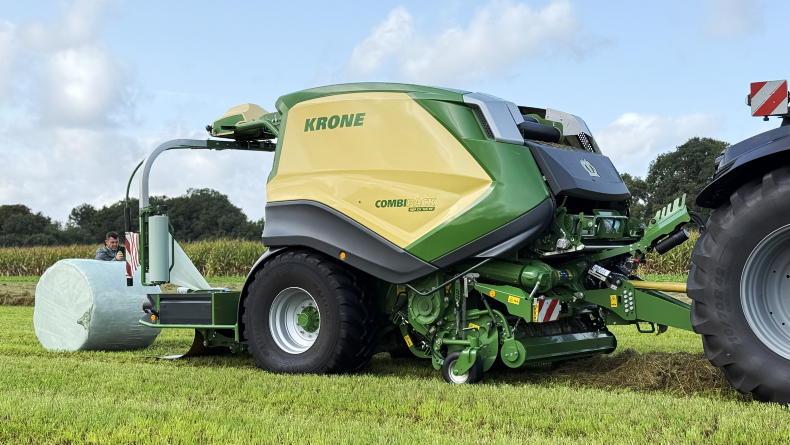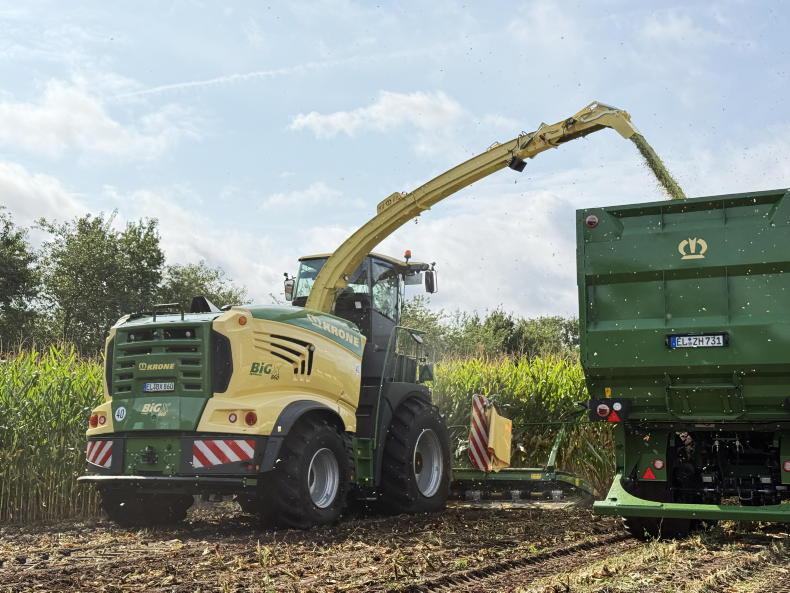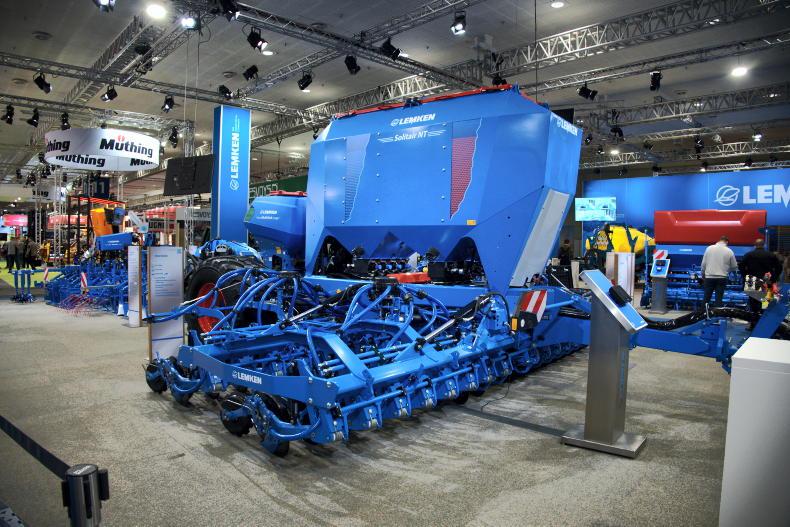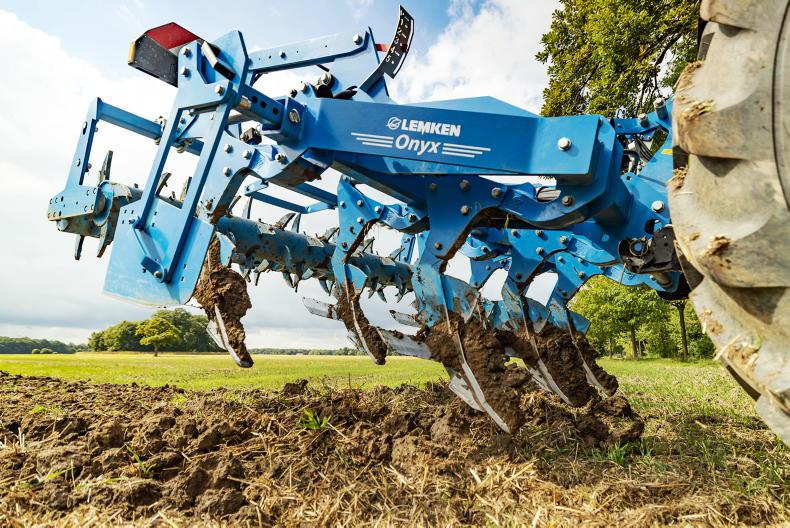Last week, implement specialists Krone and Lemken held a working demonstration of their Combined Powers concept at a field day in Germany. Combined Powers is the name of a joint project between the two German implement manufacturers and involves a diesel-electric autonomous tractor design concept. 
The incorporated diesel-electric drive generates a maximum power of 230hp (170kW).
The incorporated diesel-electric drive generates a maximum power of 230hp (170kW). Depending on the specific application and implement attached, the weight of the 2.70m wide and 2.60m high autonomous unit is between 7.5t and 8t and is fitted with 23in wheels all-round.
The manufacturers say the drive unit is designed to meet the power requirements of the implements used in processes such as cultivating, ploughing, sowing, mowing, tedding and raking. 
The operators can control and monitor the combination from a mobile device.
The companies say the drive power is transferred electrically to the wheels and the PTO, and from there to the implement which couples to a three-point linkage. The drive unit boasts multiple sensor systems which monitor the immediate surroundings and the implement attached, with safe operation and optimum results as the primary objectives. The operators can control and monitor the combination from a mobile device, transmitting jobs and job reports via a communication module and the agrirouter, the established data exchange hub. 
Depending on the application and implement attached, the weight of the autonomous unit is between 7.5t and 8t.
Controlled by the implement
In the field last week, two units were demonstrated at an event near the two manufacturers’ headquarters in Germany.
The unit in the green Krone livery operated a Krone 4m EasyCut F 400-fold front mower followed by a Vendro 820 8.2m tedder.
The Lemken blue unit on the other hand showcased its cultivation abilities pulling an adapted Lemken Karat 10 cultivator followed by an eight-row Lemken Azurit 10 K 8 precision dill. 
The drive power is transferred electrically to the wheels and the PTO, and from there to the implement which couples to a three-point linkage.
The manufacturers say that the speciality of the process unit is that it is controlled by the implement and not vice versa. The implement and the drive unit act as one integrated smart system.
Based on the long experience of using IsoBus and TIM on Krone and Lemken machines, the drive unit and implement communicate and interact, sharing all types of data. 
The drive unit boasts multiple sensor systems which monitor the immediate surroundings and the implement attached.
The aim
The two manufacturers see the Combined Powers concept as a soloution to the increasing shortage of skilled labour in agriculture.
They said: “Farmers will no longer be required to spend long days working in the field, but can act as a system operator, monitoring the unit as it consistently delivers accurate and high quality work.”
The autonomous tractor unit has been designed to operate in all seasons. The manufacturers concluded by outlining that intensive trials in all conditions, as well as user feedback from farmers and contractors, will continue in the coming year.
The manufacturers have yet to release a timeline, or when it plans to potentially hit the market. 
The drive unit boasts multiple sensor systems which monitor the immediate surroundings and the implement attached.







Last week, implement specialists Krone and Lemken held a working demonstration of their Combined Powers concept at a field day in Germany. Combined Powers is the name of a joint project between the two German implement manufacturers and involves a diesel-electric autonomous tractor design concept. 
The incorporated diesel-electric drive generates a maximum power of 230hp (170kW).
The incorporated diesel-electric drive generates a maximum power of 230hp (170kW). Depending on the specific application and implement attached, the weight of the 2.70m wide and 2.60m high autonomous unit is between 7.5t and 8t and is fitted with 23in wheels all-round.
The manufacturers say the drive unit is designed to meet the power requirements of the implements used in processes such as cultivating, ploughing, sowing, mowing, tedding and raking. 
The operators can control and monitor the combination from a mobile device.
The companies say the drive power is transferred electrically to the wheels and the PTO, and from there to the implement which couples to a three-point linkage. The drive unit boasts multiple sensor systems which monitor the immediate surroundings and the implement attached, with safe operation and optimum results as the primary objectives. The operators can control and monitor the combination from a mobile device, transmitting jobs and job reports via a communication module and the agrirouter, the established data exchange hub. 
Depending on the application and implement attached, the weight of the autonomous unit is between 7.5t and 8t.
Controlled by the implement
In the field last week, two units were demonstrated at an event near the two manufacturers’ headquarters in Germany.
The unit in the green Krone livery operated a Krone 4m EasyCut F 400-fold front mower followed by a Vendro 820 8.2m tedder.
The Lemken blue unit on the other hand showcased its cultivation abilities pulling an adapted Lemken Karat 10 cultivator followed by an eight-row Lemken Azurit 10 K 8 precision dill. 
The drive power is transferred electrically to the wheels and the PTO, and from there to the implement which couples to a three-point linkage.
The manufacturers say that the speciality of the process unit is that it is controlled by the implement and not vice versa. The implement and the drive unit act as one integrated smart system.
Based on the long experience of using IsoBus and TIM on Krone and Lemken machines, the drive unit and implement communicate and interact, sharing all types of data. 
The drive unit boasts multiple sensor systems which monitor the immediate surroundings and the implement attached.
The aim
The two manufacturers see the Combined Powers concept as a soloution to the increasing shortage of skilled labour in agriculture.
They said: “Farmers will no longer be required to spend long days working in the field, but can act as a system operator, monitoring the unit as it consistently delivers accurate and high quality work.”
The autonomous tractor unit has been designed to operate in all seasons. The manufacturers concluded by outlining that intensive trials in all conditions, as well as user feedback from farmers and contractors, will continue in the coming year.
The manufacturers have yet to release a timeline, or when it plans to potentially hit the market. 
The drive unit boasts multiple sensor systems which monitor the immediate surroundings and the implement attached.










































SHARING OPTIONS